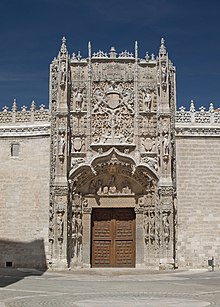Isabelline style


The term Isabelline Style (also Isabelline Gothic ) is used in the architecture of Spain to summarize buildings or parts of buildings from the reign of the Catholic Kings ( Isabella of Castile (r. 1474–1504) and Ferdinand of Aragón (r. 1479–1516)). It developed from the Spanish form of the Flamboyant style , sometimes referred to as the Florido style . The Isabelline style is considered to be an eclectic mixed style and a transition style between the late Gothic and the Renaissance ; some also see it as an early phase of the Plateresque style .
Architecture and building ornamentation
In a characteristic Isabelline architecture, elements of architectural ornamentation are the best way to identify the peculiarity of the style. Of particular note here are: the frequent use of flamboyant forms from the Flemish late Gothic period, of keel arches and jagged arches, e.g. Some with hangers , and - more rarely - of Muqarnas forms from Moorish or Mudejar art. Figures and especially heraldic shields were also popular. The personal coat of arms and name symbols of yoke ( yugo ) for Ysabella and bundles of arrows ( flechas ) for Fernando are particularly striking .
The allusions to classical antiquity in Spain are little more than literary elements, unlike in Italy, where the presence of Roman buildings was much greater and the Gothic was in a way adapted to local classical tastes. Until the 1530s and even later in Spanish architecture, the Gothic renaissance did not catch on. Lo Romano was the Renaissance style, classic, emotional, bombastic and Italian. For them, modernism was Gothic, which was structurally rational, pragmatic and effective, a typically Spanish style.
The Isabelline style has no clear hierarchy of the components, the individual ornament fields or the represented figures. Large areas (especially on portal facades) are covered with decorative elements - similar to Moorish art - in horror vacui fashion. Adjacent wall areas, however, remain completely unadorned.
Similar facade designs and décor concepts can be found a good two centuries later in the art conception of the Churrigueresque style and the colonial baroque (cf. Santa Prisca (Taxco) , San Francisco Javier (Tepotzotlán) , Il Sagrario (Mexico City) ).
Significant buildings
- San Juan de los Reyes Monastery , Toledo
- Capilla Real , Granada
- Facade of El Sagrario Church , Málaga
- Facade of the Colegio de San Gregorio , Valladolid
- Facade of the Church of San Pablo (Valladolid)
- San Jerónimo el Real Monastery , Madrid
- Facade of the Santo Tomás (Ávila) monastery
- Cartuja de Miraflores , Burgos
- Palacio del Infantado , Guadalajara
- Facade of the Palacio de Jabalquinto (Baeza)
- Facade of the Church of Santa María la Real (Aranda de Duero)
- Cloister of the cathedral, El Burgo de Osma
- Cloister of the monastery of San Salvador (Oña)
Major architects
Facade of the Cartuja de Miraflores , Burgos
San Pablo , Valladolid
Cloister of the cathedral, El Burgo de Osma
Interior of the monastery church of San Juan de los Reyes , Toledo
Facade of the Santa María la Real church , Aranda de Duero
Courtyard of the Palacio del Infantado , Guadalajara
See also
In Portugal , the Manueline style , named after King Manuel I (reigned 1495–1521), developed around the same time , which also incorporated elements of Flemish late Gothic and Moorish art, but based on motifs from seafaring (ship ropes, knots, armillary spheres etc.) enriched.
literature
- Fernando Chueca Goitia: Historia de la arquitectura española. 2 volumes, Diputación de Ávila 2001, ISBN 84-923918-7-1
Individual evidence
Web links
- Isabelline Gothic - Photos + Info (Spanish)
- Isabelline Gothic - Photos + Info (Spanish)






